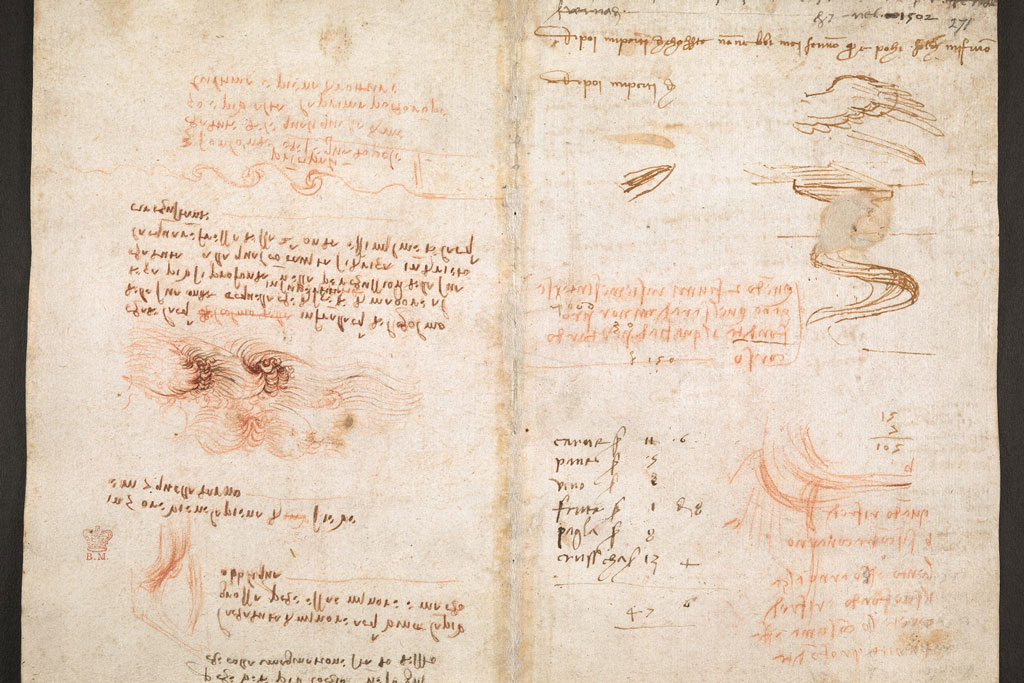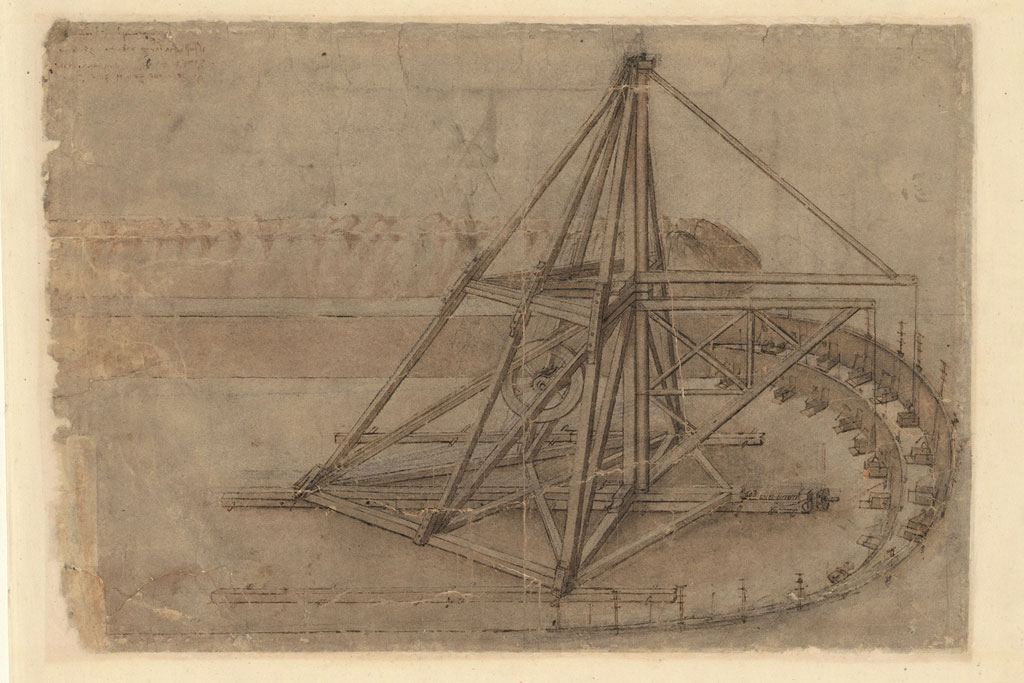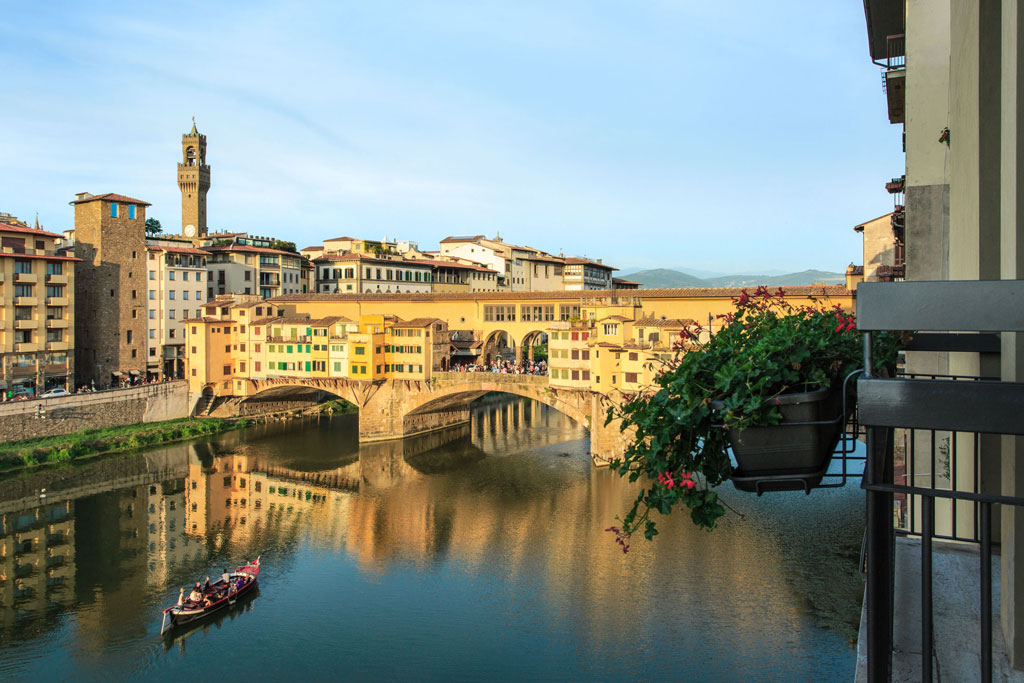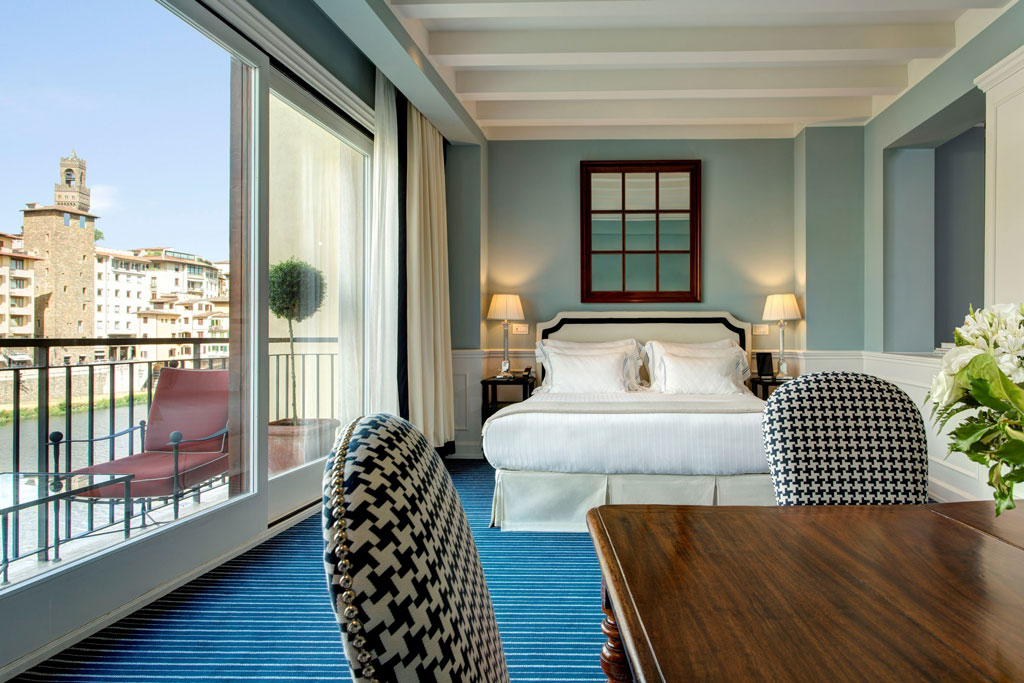Water as Microscope of Nature: Leonardo da Vinci
Leonardo da Vinci’s Codex Leicester exhibition at the Uffizi, Florence
This post may contain affiliate links. Learn more
Kamin Mohammadi visits Leonardo da Vinci’s Codex Leicester exhibition at the Uffizi, Florence…

Fig. 1
Leonardo da Vinci
The Sun and the Moon as seen from Earth. Origin of the lunar light
Codex Leicester, 1r
Courtesy Bill Gates/©bgC3
Exhibition venue
Aula Magliabechiana, The Uffizi, Florence
Exhibition dates
30 October 2018 – 20 January 2019

Fig. 7
Strabo (Amaseia, Pontus 58 B.C. circa – 25 A.D. circa)
De situ orbis
15th century
parchment Ms., illuminated, f. 1r
Biblioteca Medicea Laurenziana, Firenze
Leonardo Da Vinci: Genius
Artist, engineer, scientist, visionary – there are few people to whom the title ‘genius’ is better suited than Leonardo Da Vinci. Best known now for the enigmatic smile of the Mona Lisa, Da Vinci’s legacy spans the arts and the sciences, his famous drawings and various treaties deal with the nature of everything from the flight of birds to the movements of water to the arterial system of man. Leonardo’s accomplishments across all areas, his ability to explore the different fields of knowledge, heralding the future progress of science and technology, have made of him a unique phenomenon, a pop icon even.

Fig. 10
Pliny the Elder (Como 23 – Stabia 79)
Ricciardo di Nanni (illumination)
Naturalis Historia: Pliny’s imaginary portrait
1458
parchment Ms., with a bianchi girari (white vine meanderings), f. 3r
Biblioteca Medicea Laurenziana, Firenze
May 2019 marks 500 years since his death and, as a precursor to the celebrations this jewel-like exhibition lights up the Uffizi’s Aula Magliabechiana gallery until January of next year.
The Codex Leicester
The exhibition brings the Codex Leicester – Da Vinci’s investigation into water – back to Florence, the city where it was written. The Codex Leicester is a manuscript comprising 36 sheets covered on both sides by Da Vinci’s writing, drawings, illustrations and maps – 72 pages of his thoughts on everything to do with water. Called after its first known owner, the Earl of Leicester, who acquired it in Rome in 1717, the Codex Leicester was bought by Bill Gates in 1994, who vowed that the book would constantly travel, available for all the world to enjoy.

Fig. 21
Leonardo da Vinci
Studies for the channeling of the Arno
1504 circa
red pencil, pen and ink
Codex Arundel, ff. 278v-271r
British Library, London
“Water, the conveyor of nature’, wrote Da Vinci in the Codex, arguing that water is the element that has always been the driving force behind the evolution of our planet. The Codex Leicester contains pioneering studies on water and other related issues. Throughout this treaty, he acutely investigated water’s elementary structure in order to exploit its energy and control its often-disastrous effects.
Greeted by a video projection of the river Arno’s flowing waters as one enters, the link between the city and the Codex – the greatest part of which was written in Florence between 1501 and 1508 – is apparent throughout, highlighted by a map that portrays the Arno’s course through the city around 1500,an exceptionally fruitful period of the city’s history, years in which Leonardo, Michelangelo and Raphael were all working there.
The Best Art Exhibitions in London
Interacting with his Works
The exhibition, curated by Paolo Galluzzi, has unbound the manuscript, so that both sides of its pages are displayed, complete with Leonardo’s mirrored writing (he wrote from left to right as he was left-handed and wanted not to smear the ink by passing his hand over it), his quick drawings, plans, illustrations, and even smudges and corrections. The book is brought to life by multimedia displays in which videos illuminate the pages of the Codex, as well as the brilliant Codescope, an innovative multimedia tool which enables you to browse all the pages of the Codex Leicester and read the transcription of texts, with lots of interactive elements.

Fig. 5
Leonardo da Vinci
Interaction between water, river bed, obstacles. Hydraulic engineering
Codex Leicester, 24 r
Courtesy Bill Gates/©bgC3
This fascinating exhibition utilises the latest in technology to allow us to get up close to Leonardo and his thinking, tracing the very action of his pen as he thought and wrote, trying to keep up with his ideas. There are models of his inventions, and even fossils that support his theories on the formation of the earth, as well as a section that related his theories on water to his painting of the element in his work as an artist. Best of all, the Uffizi location means that afterwards, you can pop up to the recently renovated Leonardo gallery, and feast your eyes on masterpieces such as Adoration of the Magi (also just back from five years of renovation), the Annunciation or the Baptism of Christ, your understanding of each painting enriched by Leonardo’s obsession with probing the secrets of water in the Codex Leicester.
Where to Stay
When visiting this exhibition, there is nowhere that stays truer to the theme of water than the Hotel Lungarno. The only hotel in Florence which boasts rooms actually on the river, this glamorous boutique hotel reopened just last year after years of renovation. With delectable design, a chic spa, a bar sitting on top of the river in sight of the Ponte Vecchio, and its restaurant awarded a Michelin star in 2016, there is nowhere better to contemplate Leonardo’s reflections on the nature of water than in a river room as the Arno flows beneath your feet.
Hotel Lungarno has rooms available starting from £240 per room per night based on two adults sharing, excluding breakfast. For booking and further information please visit www.lungarnocollection.comor call +39 055 2726 4000.
16 Unique Rentals for New Year’s Eve in the UK | An Insider’s Guide to the Ski Season | Weekender: 48 Hours in Mallorca



